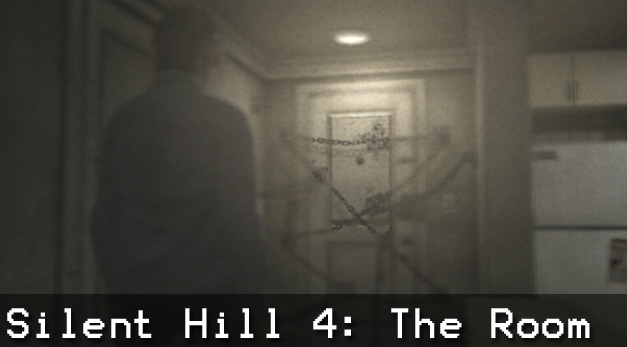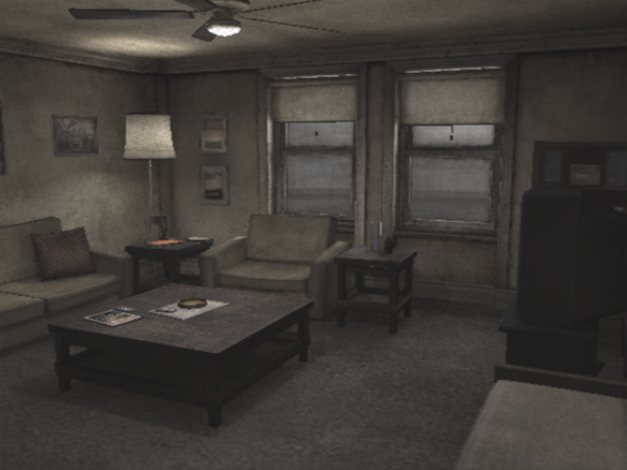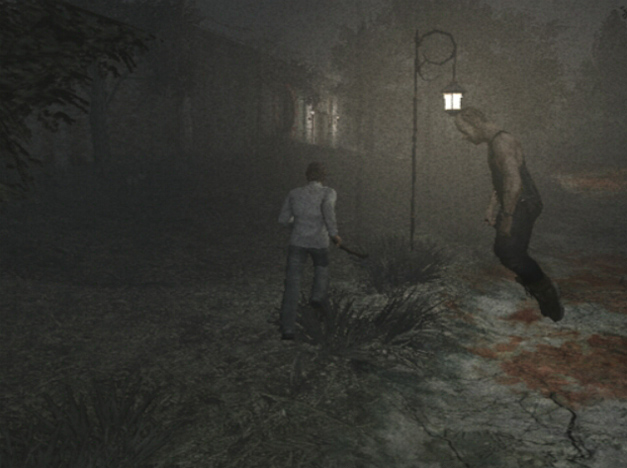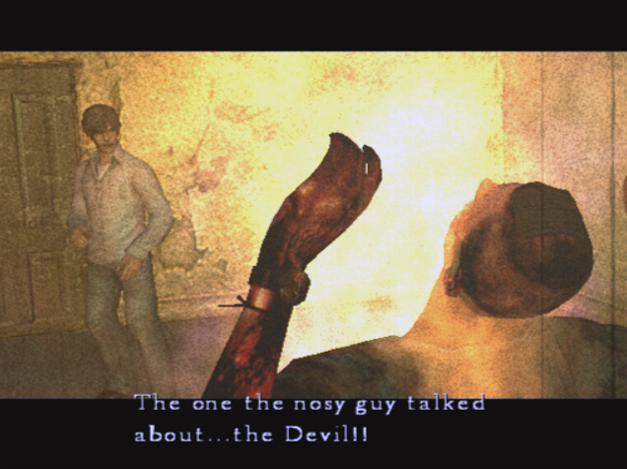
 |
Silent Hill 4: The Room
Developer: Konami Computer Entertainment Tokyo |
Being the final project for Konami's Team Silent -- which at that point was the sole team responsible for developing the Silent Hill series of games -- Silent Hill 4: The Room would go against tradition by introducing new concepts and mechanics that would cause fans of the franchise to revile and question the new direction. Because of this, it received lower scores compared to the original three, but in hindsight, could it be an underappreciated gem?
On its surface you can see a number of changes were made. For starters, parts of the game switched to a first-person perspective while at a certain location. But this is minor to where they altered the gameplay by including a hud, a first for the series to do outside of the health meter for the PC versions. The problem with this is it pulls the player out of the world and reminds them they are playing a game. But let's hold on for a minute as we are getting ahead of ourselves. Let's talk about the premise before we move on.

The protagonist is Henry Townshend, a young man living in the town of South Ashfield, a short drive from Silent Hill. He resides in the South Ashfield Heights apartment building, where he's been living for two years. Everything was fine until five days earlier when he couldn't leave his apartment unit -- Room 302. He can't open his windows, his front door is sealed behind an eerie arrangement of chains and locks which he can't undo, and his phone line is dead, isolating him from the rest of the world. Looking out his windows or front door peephole he can see life moving normally all around him, but his cries for help go unanswered because no one can hear nor see him regardless of how loud he yells or bangs on the door.
One day an unearthly hole appears on his bathroom wall. Seeing it as an escape from his apartment he climbs through it, but only to discover it leads him to a dreamlike world that is both familiar and alien at the same time. With no other way out, he is forced to explore this new reality and seek a way back to his own.
But when it comes to exploring, this is the first game where we no longer have the ability to wander around the town's foggy streets and alleyways. You're completely tied to a liner route, only able to walk the set path they want you to take for you to get to your next destination. The bit of freedom you do have is the ability to return to your one-bedroom apartment by entering holes that are similar looking to the one found in your bathroom. It's the place you go to when you need to save your game or to drop off some items due to the game now including a limited inventory system. If anything, it's the hub world you need to turn back to every so often.

With this hub world, it is used as an alternative for exploring the town. Instead, you are now inspecting every square inch of room 302 because something in it could be of use to solve a puzzle in the otherworld like using the kitchen sink to rinse off an object or grabbing an item found in the refrigerator and bringing it with you to the otherworld. In addition, looking out the window or peephole expands on the spooky atmosphere as you can eavesdrop on conversations being discussed near your front door or peering into the windows of your fellow tenants across the parking lot. When in your apartment, it changes to the first-person perspective and also disables your ability to use weapons, making you feel a bit vulnerable due to the claustrophobic design of the unit and slow ability to move around such as turning. Overtime, hauntings will begin to occur in the apartment, adding more stress to an already terrible situation.
The worlds you walk around in will be familiar looking to Henry due to some locations taking place around the surrounding neighborhood in South Ashfield, but others are completely foreign. Take for example the subway station located in front of his apartment building. He's been there before and recognizes it, but at the same time its warped and twisted looking innards confuse him making him wonder what the heck is wrong with everything he knows. Uncomfortableness dealing with familiarity.
Along the way Henry will cross paths with someone in each of the worlds he visits, only to later find them murdered in some horrible way with a cryptic message carved into their skin with a knife, letting you know it's someone specific who's hunting each of them down. And that's one of the reasons that separate this Silent Hill story from the rest as it's more of a mystery thriller than it is a straight horror story.
With Silent Hill 1 and 3 it's about the cult and their shenanigans. With Silent Hill 2 it's about a man seeking redemption. With SH4, you're not really sure what's going on until you begin connecting all the dots from every scrap of info you've managed to find along your journey. And the way they have you collect all these clues was really well done. Some of it is found near your front door as someone is sliding sheets of paper from a journal under the door, another is listening to news reports on the radio, while other times you're secretly listening to conversations around the apartment, and of course, reading books, magazines, and other kinds of documents you find while in the otherworld.

When it comes to the technical side, SH4 is a bit disappointing when compared to the original three games. If you were looking to get the stock checklist of items the series is known for, then you might have been miffed when you sat down and started playing. For starters, the graphics don't look better or even on par with its predecessor, Silent Hill 3. When strictly discussing graphics, it looks better than SH2, but inferior to SH3. Then there's the fog, or what little of it there is. Only a few stages have it, but it thinly veils the world it's trying to cover, making it more like a misty night than it is a thick blanket of fog. And related to this is the lighting. The world is lit up enough to where you don't need a flashlight to guide you on where to go, allowing you to see monsters long before you get to them, removing some of the tension.
To make up for that, the tension is widely centered with a specific type of monster. With this installment, we deal with poltergeists in a big way; something the series tended to steer away from but now fully embraces. It's high tension when you come across one because they tend to cling to you tightly and move swiftly across the environment. You can't kill them like other monsters so you have to deal with them constantly. And you don't want to be in the same area with them for long because they are disturbing to look at as their bodies are fixed in odd positions as they levitate in the air.
This also has to be the largest cast the Silent Hill series ever had. Normally they keep it tight to around four or five, but this one has about ten speaking roles and over a dozen non-speaking characters. The larger number of characters is essential to have as again this is more of a mystery thriller so there needs to be a lot more people involved so we can later draw lines and connect dots in order to figure out how everything and everyone fits together. And while on the surface the details of some of the characters will seem shallow at first, but later on you'll discover just how deep some go and cross with other characters.

It's been said that Silent Hill 4 originally begun as a non-Silent Hill game but became one sometime during its development. This is often used to explain why its gameplay differs when compared to the original three games. And setting it apart even more is how much it refers back to story elements found in its predecessors, making it feel even more of an outsider than being part of the series. For starters, the main driving force for SH4 is based on a magazine article found in SH2. An editorial found in SH3 does an in-depth investigation on the cult's activities in and around Silent Hill. SH4 magnifies what is written in these articles so to flesh it out more to give insight on how the cult actually functions as an organization. Also, characters from all three previous games are referenced in some way or another to show how intertwined everybody is to the cult's odd religion.
While turning the story from a horror themed to one that leads as a mystery thriller may have been a bold change, it was one the mainstream audience didn't seem to care for. In order to keep the series from going stagnant, it seems like the most logical choice to make as the genres share so many different kinds of elements. Most would say Silent Hill 2 is the best in the series and would argue that making more games in that style of having the unreliable narrator would have saved the series. Well, after Team Silent was shuttered, western developers would follow in the same vein as SH2, and those games such as Homecoming and Downpour had dismal results in both sales and reviews, demonstrating how following the same type of narrative isn't always the best answer.
Posted on: October 31, 2016
